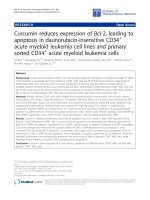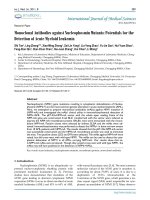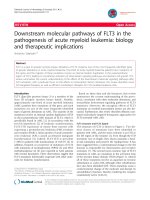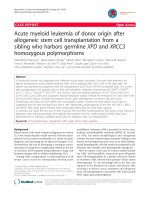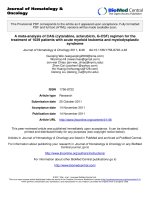Characterisation of the effects and mechanism of action of rapamycin and genistein on acute myeloid leukemia using high throughput techniques
Bạn đang xem bản rút gọn của tài liệu. Xem và tải ngay bản đầy đủ của tài liệu tại đây (2.6 MB, 202 trang )
CHARACTERISATION OF THE EFFECTS AND MECHANISM OF
ACTION OF RAPAMYCIN AND GENISTEIN ON ACUTE MYELOID
LEUKEMIA USING HIGH-THROUGHPUT TECHNIQUES
KARTHIK NARASIMHAN
(B.Tech, Biotechnology)
A THESIS SUBMITTED FOR THE DEGREE OF
DOCTOR OF PHILOSOPHY
DEPARTMENT OF BIOLOGICAL SCIENCES
NATIONAL UNIVERSITY OF SINGAPORE
2010
i
ACKNOWLEDGEMENTS
Words don‟t do justice to the heartfelt gratitude that I would like express to my supervisor,
Dr.Lin Qingsong for the support, encouragement and invaluable guidance that he has
provided me. He has been a friend, philosopher and guide, a constant source of
encouragement, and a fountainhead of inspiration- in short the best supervisor one could
possible ask for. I thank him for the confidence that he reposed in me and the scientific
temper that he inculcated in me.
I would like to thank Dr.Prakash Kumar and Dr.Kunjithapadham Swaminathan for their
mentorship and counsel. I‟m deeply indebted to Dr.Paul Hutchinson of the „Flow lab‟ of
CeLS for his assistance and insights in performing the flow cytometry work. My previous
supervisor Dr.Han Jin Hua was instrumental in helping me initiate my research, for which I‟m
very thankful to her.
I owe a great deal to the help and support of Lim Teck Kwang, our research assistant, Tay
Bee Ling and all my lab mates for the stimulating research atmosphere that they provided in
the lab. My thanks are due to Sarah Port and Aravind Menon, two excellent students, whom I
had the pleasure of guiding and supervising.
My family has always believed in me and have been an unwavering source of support in all
my endeavours. My father, mother, brother, grandparents, mama and mami have been my
pillars of strength. It is the implicit faith and unconditional affection that they showered on
me, which gave me the confidence and courage to brave the thrills and chills of research life.
„Some people go to priests; others to poetry‟; and I to my friends- Aravind, Ayshwarya,
Gauri, Pradeepa, Prasanna, Priya, Satish, Sheela, and Sravanthy. Life would not have been the
same without them. I would like to thank them for all the hours spent in the canteen over
mindless chats, days spent discussing science, and years spent looking out for each other
through the thick and thin of time!
ii
TABLE OF CONTENTS
ACKNOWLEDGEMENTS i
TABLE OF CONTENTS ii
SUMMARY vii
LIST OF TABLES ix
LIST OF FIGURES x
LIST OF ABBREVIATIONS xii
CHAPTER 1 1
REVIEW OF LITERATURE 1
1.1 Cancer 1
1.2 Acute Myeloid Leukemia 2
1.2.1 Biology of AML 4
1.2.2 Epidemiology of AML 7
1.2.3 Aetiology of the disease 8
1.2.4 Genetic abnormalities in AML 8
1.3 Current treatment strategies for AML 10
1.4 Rapamycin 13
1.4.1 Discovery and physical properties 13
1.4.2 Rapamycin as an immunosuppressant 16
1.4.3 Antifungal properties of rapamycin 16
1.4.4 Mechanism of action of rapa 17
1.4.4.1 Structure of the mTOR protein 17
1.4.5 Rapamycin as an anti-cancer agent 20
iii
1.5 Genistein 21
1.5.1 Physical properties 21
1.5.2 Versatility of GEN 24
1.5.3 Anti-cancer properties of GEN 24
1.5.4 GEN as a potential therapeutic agent for AML 25
1.5.5 GEN- a potent tyrosine kinase inhibitor 26
1.6 High-throughput approaches to mechanistic studies of drugs 27
1.6.1 Transcriptomic profiling and microarray technology 28
1.6.2 Affymetrix Genechip analysis 29
1.6.3 „Proteomics‟- scope and definition 33
CHAPTER 2 43
AIMS OF THE STUDY 43
CHAPTER 3 45
MATERIALS AND METHODS 45
3.1 Cell Culture 45
3.2 In vitro cytotoxicity assay 45
3.3 Transcriptomic analysis using microarray 46
3.3.1 RNA extraction 46
3.3.2 Affymetrix Genechip analysis 48
3.4 Data analysis 51
3.5 isobaric Tag for Relative and Absolute Quantification (iTRAQ) labelling 51
3.5.1 Protein extraction and sample preparation for iTRAQ labelling 52
3.5.2 Cation exchange, purification and desalting of labelled samples 54
iv
3.5.3 2D-LC separation of Labelled Peptides 54
3.5.4 Mass Spectrometry Analysis and Database search 55
3.5.5 Determination of the significant cut-off threshold for fold-change 57
3.5.6 Estimation of false positive rate to determine cut-off score 57
3.6 Quantitative Real-Time PCR validation of microarray and iTRAQ data 58
3.7 Pathway Analysis 62
3.8 Protein Extraction for western blot analysis 62
3.9 Western Blot 63
3.10 Cell Cycle Analysis 65
3.11 Caspase 3/7 Assay 65
3.12 Annexin V-FITC apoptosis detection 66
3.13 Measurement of ROS levels in cells 67
3.14 Nascent protein synthesis quantification using Click chemistry 67
CHAPTER 4 70
HIGH-THROUGHPUT CHARACTERISATION OF THE EFFECTS OF RAPA ON
AML 70
4.1 Introduction 70
4.2 Results 71
4.2.1 Rapa has cell line specific growth inhibitory effects on different AML cells 71
4.2.2 Gene expression profiles of AML cells treated with rapa 74
4.2.3 Mapping the alterations in the proteome using iTRAQ labelling 79
4.2.4 Rapa regulates a variety of pathways in AML 82
4.2.5 Validation of the microarray data by quantitative real-time PCR 87
v
4.2.6 Rapa causes G1 arrest in AML 90
4.2.7 Analysis of the change in the level of cell cycle proteins upon rapa treatment 92
4.2.8 Rapa represses Skp2 and hence up-regulates p27 leading to G1 arrest 95
4.2.9 Confirmation of mTOR arrest by rapa 95
4.2.10 Rapa regulates the IGF-1 pathway and inhibits IGFBP2- a novel discovery 96
4.2.11 Rapamycin does not induce apoptosis in AML 98
4.3 Discussion 101
4.3.1 Advantages of the approach 101
4.3.2 The cell cycle: G1/S checkpoint regulation pathway 102
4.3.3 Linking Protein Ubiquitination to G1 arrest through Skp2 regulation 105
4.3.4 The IGF-1 signalling pathway modulation and down-regulation of IGFBP2 107
4.3.5 Rapa is cytostatic- not cytotoxic 108
4.3.6 Hypoxia signalling regulation by rapamycin 108
4.3.7 Conclusion and Key findings 109
CHAPTER 5 112
PROTEOMIC INVESTIGATION OF THE ANTI-LEUKEMIC ACTIVITY OF GEN
112
5.1 Introduction 112
5.2 Results 113
5.2.1 Genistein exerts strong anti-proliferative effects on AML cell lines 113
5.2.2 GEN is a FLT3 inhibitor 116
5.2.3 8-plex iTRAQ based profiling of the proteome level changes induced by genistein
118
vi
5.2.4 Genistein regulates crucial pathways in MV4-11 and HL-60 cells 124
5.2.5 Genistein modulates mTOR pathway- an erstwhile unknown arrow in genistein‟s
quiver 130
5.2.6 Protein synthesis mechanism- an important target of genistein 132
5.2.7 Akt regulation- One stop solution to many questions? 134
5.2.8 Genistein increases ROS levels in leukemia cells 134
5.2.9 Mechanism of cell death caused by genistein 136
5.2.10 Deciphering the mode of cell cycle arrest caused by GEN 140
5.3 Discussion- Piecing together the puzzle! 143
5.3.1 Significance of GEN‟s FLT3 inhibitory effect 143
5.3.2 High-throughput study and the story that it presents 144
5.3.3 The tale of two modes of “death” 149
5.3.4 Divergent effects of GEN on Cell Cycle Progression 151
5.3.5 Summarising the effects of GEN on AML 152
5.3.6 Examining the role of FLT3 in the story 154
5.4 Significance and Concluding Remarks 155
CHAPTER 6 158
FUTURE DIRECTIONS 158
6.1 Rapamycin based AML treatment- What lies ahead? 158
6.2 Genistein- Novelties abound and an exciting future! 159
REFERENCES 161
APPENDIX I 174
LIST OF PUBLICATIONS 187
vii
SUMMARY
Acute Myeloid Leukemia (AML), caused by the uncontrolled proliferation of the leukocytes
of the myeloid lineage, is a cancer with a very high mortality rate. Present therapies to treat
AML include chemotherapy and bone marrow transplant. These methods suffer from certain
inherent limitations such as heavy cytotoxicity and innocent bystander effects in the case of
the former and acute allograft rejection in the latter. Hence there is an urgent need for more
effective therapeutic strategies.
In this study, we have evaluated the efficacy of two such potential therapeutic drugs, namely
Rapamycin (rapa) and Genistein (GEN) and have characterised their mechanism of action
using high-throughput strategies. A combination of microarray and 4-plex iTRAQ based
approach was adopted to study the effects of rapa on MV4-11 and THP-1 cells and an 8-plex
iTRAQ based methodology was employed to profile the proteome of the MV4-11 and HL-60
cells treated with GEN.
We found that rapa had potent anti-proliferative effect on all the AML cell lines tested. We
chose the cell lines with the lowest and highest IC
50
, MV4-11 and THP-1 respectively, for
functional characterisation. High-throughput studies indicated that rapa regulates Cell cycle,
IGF-1 and FGF signalling, death receptor signalling, protein ubiquitination and hypoxia
signalling pathways. Functional studies showed that rapa did not induce apoptosis but
effected a time-dependent G1 arrest, with the peak inhibitory effect at 16 h. Interestingly, rapa
down-regulated IGFBP2, usually elevated in AML patients. Our study showed that rapa
represses Skp2, an important constituent of the protein ubiquitination pathway. Working on
this clue, we identified that the time dependent G1 arrest is in fact the result of the inhibition
of Skp2, leading to the accumulation of p27, which in turn causes repression of Cdk2 and
Cdk4.
In the second study, we found that GEN had inhibitory effects on both the MV4-11 (IC
50
20µM) and HL-60 (IC
50
30µM) cells. We discovered that GEN inhibited the constitutive
viii
phosphorylation of FLT3 in the MV4-11 cells, which carry the FLT3-ITD (Internal Tandem
Duplication) mutations. However, GEN had potent anti-leukemic effects on the HL-60 cells
too, in spite of them possessing the wild-type version of the gene.
A purely proteomic-based approach, using the 8-plex iTRAQ strategy, was employed to
understand the dynamics of GEN‟s effects on the two subsets of AML. We found that GEN
down-regulated the mTOR pathway, thus arresting protein synthesis in the AML cells. GEN
up-regulated Akt, leading to elevation in the reactive oxygen species (ROS) levels which in
turn caused apoptosis. While HL-60 underwent a caspase- mediated cell death, the apoptosis
in MV4-11 was caspase independent. GEN induced arrest at the G2/M phase of the cell cycle
in HL-60 while it caused a moderate G1 arrest in MV4-11. We can attribute these differences
in the mechanism of action of GEN to the FLT3 mutational status of the two cell lines. Hence,
we conclude that GEN has an all encompassing anti-proliferative effect on AML irrespective
of its FLT3 mutational status and is an ideal candidate for clinical trials.
ix
LIST OF TABLES
Table 1.1
Classification of leukemia by lineage and tumourigenicity
3
Table 1.2
French-American-British (FAB) system of classification of AML
4
Table 1.3
World Health Organisation (WHO) classification of AML
6
Table 1.4
FLT3 inhibitors in different stages of development
12
Table 3.1
iTRAQ labelling plan for rapa treated samples
52
Table 3.2
iTRAQ labelling plan for GEN treated samples
56
Table 3.3
2X Reverse transcription master mix recipe
59
Table 3.4
PCR program for reverse transcription reaction
59
Table 3.5
List of primers used for real-time PCR
61
Table 3.6
Antibody dilutions and blocking conditions used for western
immunoblotting
64
Table 3.7
Click-iT® reaction cocktail preparation methodology
69
Table 4.1
IC
50
concentration for various AML cell lines after 48 h treatment
of rapa
72
Table 4.2
Rapa regulates a large number of genes in AML
76
Table 4.3
Proteins regulated by rapa in (A) MV4-11, (B) THP-1, as
identified from the iTRAQ study
79
Table 4.4
Biological functions regulated by rapa in AML
83
Table 4.5
Key canonical pathways regulated by rapa in AML
85
Table 4.6
Real-Time PCR validation of microarray data
88
Table 4.7
Cyclin-Cdk protein complexes and their stage of activity
104
Table 5.1
Summary of LC/MS/MS results obtained from the iTRAQ study
119
Table 5.2
Canonical Pathways regulated by GEN in (a) MV4-11 (b) HL-60
128
Table 5.3
Tabular comparison of effects of GEN on the two AML models
153
x
LIST OF FIGURES
Figure 1.1
Common genetic abnormalities associated with AML
9
Figure 1.2
Chemical structure of rapamycin
15
Figure 1.3
Architecture of the mTOR protein
19
Figure 1.4
Chemical structure of genistein
23
Figure 1.5
Overview of the Genechip microarray analysis
32
Figure 1.6
Illustration of (a) 4-plex and (b) 8-plex iTRAQ reagent chemistry
38
Figure 1.7
Workflow of (a) 4-plex and (b) 8-plex iTRAQ procedure
40
Figure 3.1
Workflow of Genechip array sample processing and array scanning
50
Figure 4.1
Dose-response curves of cell lines after 48 h of rapa treatment
73
Figure 4.2
Venn Diagrammatic comparison of transcriptome profiles of MV4-
11 and THP-1
75
Figure 4.3
Hierarchical clustering of transcriptomic profiles of microarray data
78
Figure 4.4
Linear regression analysis of fold-changes of regulated genes
identified from microarray and real-time PCR studies
89
Figure 4.5
Rapa induces time dependent G1 arrest in (a) MV4-11 (b) THP-1
91
Figure 4.6
Western blots of cell cycle proteins regulated by rapa
93
Figure 4.7
Rapa inhibits IGFBP2 and mTOR
97
Figure 4.8
Assaying for apoptosis using (a) Annexin-V-FITC (b) Caspase 3/7
assay
99
Figure 4.9
Stages of the cell cycle
103
Figure 4.10
Summary of the mechanism of cell growth arrest employed by rapa
111
Figure 5.1
Anti-proliferative activity of GEN (a) Dose dependent inhibitory
effects at 48h and (b) Time dependent inhibitory effects at 20µM
dosage for MV4-11 and 30 µM dosage for HL-60.
115
Figure 5.2
GEN is a FLT3 inhibitor
117
Figure 5.3
Scatter plot analysis of the proteomics data
121
Figure 5.4
Venn Diagrammatic comparison of the regulated proteins identified
from the proteomic study
123
Figure 5.5
Biological functions regulated by GEN in (a) MV4-11 (b) HL-60
125
Figure 5.6
Western blot validation of certain key proteins regulated by GEN in
AML
131
Figure 5.7
GEN arrest protein synthesis in MV4-11 and HL-60
133
xi
Figure 5.8
GEN induces ROS accumulation in MV4-11 and HL-60
135
Figure 5.9
GEN causes apoptosis in (a) MV4-11 (b) HL-60
137
Figure 5.10
GEN exerts a duality in its apoptotic mechanism
139
Figure 5.11
Cell cycle regulation by GEN in (a) MV4-11 (b) HL-60
141
Figure 5.12
Summary of the effects of GEN on AML
157
xii
LIST OF ABBREVIATIONS
2-D
Two- dimensional
2-DE
Two- dimensional electrophoresis
4EBP-1
4E binding protein 1
ACN
Acetonitrile
AML
Acute myeloid leukemia
APL
Acute promyelocytic leukemia
ATO
Arsenic trioxide
ATRA
All transretinoic acid
BSA
Bovine serum albumin
C.I
Confidence interval
CBF
Core binding factor
Cdk
Cyclin dependent kinase
CDKI
Cyclin dependent kinase inhibitor
Da
Dalton
DMSO
Dimethyl sulfoxide
ESI
Electrospray ionisation
FAB
French American British
FACS
Fluorescence activated cell sorting
FCS
Fetal calf serum
FITC
Fluorescein isothiocyanate
FLT3
Fms-like tyrosine kinase 3
FLT3-ITD
Fms-like tyrosine kinase 3- internal tandem duplication
GEN
Genistein
GO
Gene ontology
h
Hour
HAMMOC
Hydroxy Acid-Modified Metal Oxide Chromatography
HRP
Horse radish peroxidase
IC
50
Half maximal inhibitory concentration
ICAT
Isotope-Coded Affinity Tags
xiii
IPA
Ingenuity pathway analysis
IPI
International Protein Index
iTRAQ
isobaric Tag for Relative and Absolute Quantitation
LC/MS
Liquid chromatography/mass spectrometry
M
Molar
MAPK
Mitogen activated protein kinase
min
Minute
ml
Milli litre
mM
Milli molar
MMTS
Methylmethanethiosulphate
MS
Mass spectrometry
mTOR
mammalian Target Of Rapamycin
MTS
3-(4,5-dimethylthiazol-2-yl)-5-(3-carboxymethoxyphenyl)-2-(4-
sulfophenyl)-2H-tetrazolium
nM
Nano molar
P.I
propidium iodide
p70S6K
p70S6 kinase
PBS
Phosphate buffered saline
PBS-T
Phosphate buffered saline- Tween
PEITC
β-phenylethyl isothiocyanate
PI3K
Phosphatidylinositol-3 kinase
PKM2
Pyruvate kinase M2
PS
Phosphatidylserine
PTK
Protein tyrosine kinase
PTM
Post-translational modification
PVDF
Polyvinylidene fluoride
Rapa
Rapamcyin
RC DC
Reducing agent and detergent compatible
ROS
Reactive oxygen species
rpm
Rotations per minute
RT
Real time
xiv
RTK
Receptor tyrosine kinase
RTKIII
Class III receptor tyrosine kinase family
s
Second
S/N
Signal to noise ratio
SDS
Sodium dodecyl sulphate
SDS-PAGE
Sodium dodecyl sulphate- polyacrylamide gel electrophoresis
SILAC
Stable isotope labelling by amino acid in cell culture
Skp2
S-phase kinase-associated protein 2
TCEP
Tris-(2-carboxyethyl) phosphine
TEAB
Triethylammonium bicarbonate Buffer
WBC
White blood cells
WHO
World health organisation
μ
Micron
μg
Microgram
μl
Microlitre
μM
Micro molar
1
CHAPTER 1
REVIEW OF LITERATURE
The literature review section comprises of an in-depth examination of the biology of acute
myeloid leukemia, the drugs rapamycin and genistein, and an evaluation of the advantages of
combining high-throughput approaches and functional analyses to study the mechanism of
action of drugs.
1.1 Cancer
Cancer is a disease which is defined by the uncontrolled growth and proliferation of a group
of cells. Cancer has afflicted humans for a long time. It is the leading cause of death in the
western countries, second only to heart disease. According to the American Cancer Society‟s
reports, the disease accounts for nearly 23.1% of all deaths in the United States of America
alone. In Singapore too, the statistics show a similar trend, with cancer causing 25.6% of all
deaths (Look, et al., 2001), making it one of the leading causes of mortality.
Cancer is a composite disease and is classified based on the individual organs and systems of
the body where it develops. In clinical terms, cancer is defined as a collective term to include
a large number of complex diseases, up to a hundred, that behave differently depending upon
the cell types that they originate from. Cancers of the blood, liver, lung, breast, ovary, cervix,
prostate, testis, colon, rectum, pancreas, lymph and kidney, are among the common
manifestations of this disease.
Metastasis refers to the spreading of cancer from its primary site of origin to other parts of the
body. The lethal combination of uncontrolled cell proliferation and metastasis makes cancer
cells highly dangerous. Most cancers, with the notable exception of leukemia, are
characterised by the formation of a tumour, a lesion like growth of an abnormal cluster of
cells. Tumours could be benign (harmless, non-metastatic), pre-malign, or malign (harmful,
2
cancerous, and metastatic). While benign tumours can be surgically removed with no serious
harm, malignant tumours are very difficult to treat.
Cancer is a genetic disease involving a multitude of genomic alterations such as single-
nucleotide substitutions, large-scale chromosomal rearrangements, amplifications and
deletions. The development of cancer is a multistep process and is influenced by a variety of
risk factors such as age, sex, life style, diet, genetic makeup, etc. The causal factors
contributing to cancer development are diverse. It is often a culmination of multiple factors
that interact over a long period of time. On the one hand, the risk factors include heredity,
abnormal genetic regulation and genetic makeup of some individuals. On the other hand, in
many cases, the onset of the disease may be due to certain cancer causing agents called
carcinogens such as tobacco and ionising radiations (Sasco, et al., 2004). It has been found
that some viruses such as the human papillomavirus also induce tumours (zur Hausen, 2009).
One of the most lethal among the various types of cancers is acute myeloid leukemia.
1.2 Acute Myeloid Leukemia
The etymology of the term „leukemia‟ is derived from ancient Greek, „leukos‟ meaning white
and „aima‟ meaning blood. It is the cancer of white blood cells (leukocytes). It is a
hematopoietic stem cell disorder characterised by a block in differentiation of hematopoiesis,
resulting in growth of a clonal population of neoplastic cells or blasts. It is broadly classified
into 2 categories:
1) Acute Leukemia: This is the result of rapid increase in the levels of immature blood cells.
It is the most common type of leukemia in children. It progresses fast and hence requires
immediate treatment. The malignant cells if left untreated, pose the risk of metastasising
through the bloodstream into other organs of the body.
2) Chronic Leukemia: This is characterised by the accumulation of relatively mature blood
cells, over a period of months to years. In contrast with acute leukemia, chronic leukemia is
3
monitored over a period of time to ensure maximum effectiveness of the therapy. The
frequency of affliction is greater among older people.
Additionally leukemia is subdivided based on the type of white blood cells (WBC) affected.
Hence there are two subdivisions based on this classification method, namely:
a) Lymphocytic leukemia: The cancer develops in the lymphoid lineage of cells.
b) Myelogenous (myeloid) leukemia: The cancer occurs in the myeloid lineage of cells.
Hence by the combination of these two classification strategies, we recognise four types of
leukemia (Table 1.1):
Table 1.1: Classification of leukemia by lineage and tumourigenicity
Affected cell lineage
Acute
Chronic
Lymphocytic
Acute lymphocytic leukemia
Chronic lymphocytic leukemia
Myelogenous
(Myeloid)
Acute myelogenous leukemia
Chronic myelogenous leukemia
4
1.2.1 Biology of AML
Acute Myeloid Leukemia (AML) is a cancer of the leukocytes of myeloid lineage,
distinguished by uncontrolled proliferation of hematopoietic precursor cells with decreased
rate of self destruction and impaired differentiation. They comprise a heterogeneous group of
malignancies of hematopoietic progenitor cells with different genetic abnormalities, clinical
characteristics, and variable outcomes with currently available treatments (Gilliland and
Tallman, 2002). The diagnosis of AML is now established when at least 20% of the cells
identified in the blood or bone marrow are blasts of myeloid origin.
AML is principally classified based on the French-American-British (FAB) system, devised
in 1976, which was later reviewed and revised in 1985. This is the most widely used system
and the default methodology adopted to classify AML. AML is categorised eight-fold hence
in Table 1.2.
Table 1.2: French-American-British (FAB) system of classification of AML
Category
Morphology
Incidence (%)
M0
AML with no differentiation
3
M1
AML without maturation
15-20
M2
AML with granulocytic maturation
25-30
M3
Hypergranular APML
5-10
M3 variant
Hypogranular variant APML
M4
Acute myelomonocytic leukemia
25-30
M5a
Acute monoblastic leukemia
2-10
M5b
Acute monocytic leukemia
M6
Erythroleukemia
3-5
M7
Megakaryoblastic leukemia
3-12
5
The classification depends on accurate morphological and cytochemical quantitation of the
degree of differentiation and level of lineage commitment. The classification of AML in this
system is defined by the presence of greater than 30% myeloid blasts in the bone marrow
(Smith, et al., 2004) and their reactivity with histochemical stains, including
myeloperoxidase, Sudan black, and the nonspecific esterases α-naphthylacetate and
naphthylbutyrate.
An alternate system of classification is adopted by WHO which aims to demarcate distinct
clinical entities within the spectrum of AML types as listed in Table 1.3. However this system
is specialised and not used in common parlance.
6
Table 1.3: World Health Organisation (WHO) classification of AML
Category
Morphology
Incidence
(%)
AML with recurrent
cytogenetic
translocations
AML with features of t(8;21)(q22;q22)
AML with features of t(15;17)(q22;q12)
AML with features of inv(16)(p13;q22)
AML with 11q23
5–12
10–15
5
3-5
AML with MDS-related
features
AML with multi-lineage dysplasia
AML arising in previous MDS
10–15
Acute myeloid leukaemia,
unspecified
AML minimally differentiated [M0]
AML without maturation [M1]
AML with maturation [M2]
Acute myelomonocytic leukaemia [M4]
Acute monocytic leukaemia [M5]
Acute erythroid leukaemia [M6]
Acute megakaryocytic leukaemia [M7]
Acute basophilic leukaemia
Acute panmyelosis with myelofibrosis
40–50
AML, therapy related
Alkylating agent-related
Epipodophyllotoxin related
Other types
5–10
7
1.2.2 Epidemiology of AML
AML accounts for 30% of all adult leukemia incidences. The epidemiology of AML shows
some interesting trends. The disease has an incidence of 3.7 per 100,000 persons in the U.S.A.
However it has an age-dependent mortality of 2.7 to nearly 18 per 100,000 persons.
According to the American Cancer Society, 31,500 individuals in the U.S. will be diagnosed
with leukemia annually. An estimated 21,500 patients will die of this disease. The annual
incidence rates in Europe were between 2 and 4 per 100,000. In Singapore, leukemia is the
tenth most common cancer among males ( />cancer-facts-n-figures.shtml). Although it is a relatively rare form of cancer, it has
disproportionate survival rates in comparison to other cancer types. The incidence of acute
leukemia is <3% of all cancers, and yet it constitutes the leading cause of death due to cancer
in children and persons age <39 years (Deschler and Lübbert, 2006).
The median age of patients afflicted with this disease is 65. The survival rates of patients are
age dependent. In Europe, five year relative survival decreased markedly with age. While
37% of patients between the 15–45 years age bracket survived, the rate among the oldest
patients- aged 75 years and over was only 2% (Smith, et al., 2004).
8
1.2.3 Aetiology of the disease
There are many risk factors for AML. Age is an important factor among others as described
earlier. It is a disease predominantly of later adulthood. Familial history of haematological
disease is another factor. Genetic disorders including Down syndrome, Klinefelter syndrome,
Patau syndrome, Ataxia telangiectasia, Shwachman syndrome, Kostman syndrome,
Neurofibromatosis, Fanconi anemia, Li-Fraumeni syndrome, etc greatly increase the
vulnerability to AML (Deschler and Lübbert, 2006).
Exposure to toxic chemical agents such as benzene, pesticides, cigarette smoking, embalming
fluids, herbicides and radiation such as ionising rays from nuclear bombs, and medical
procedures are high risk factors (Deschler and Lübbert, 2006) (Smith, et al., 2004). In some
cases even certain kinds of drugs and chemotherapeutic agents have proven to increase the
susceptibility to AML depending on the dosage and patient characteristics. These include
alkylating agents, anthracyclines, taxanes, fludarabine, chlorambucil and cyclophosphamide
(Morrison, et al., 2002; Verma, et al., 2009).
RNA retroviruses have been found to cause many neoplasms in many cancers including
leukemia, albeit a clear link hasn‟t been identified yet. Parvovirus B19 seems to play a major
role in the pathogenesis of AML (Kerr, et al., 2003).
1.2.4 Genetic abnormalities in AML
AML is characterised by many genetic translocations and mutations. They frequently occur in
leukemia incidences. The Figure 1.1 lists the common mutations which predominate acute
leukemias. Prominent among them is associated with t(1t5;17)(q22;q12) giving rise to the
PML/RARα fusion in the case of acute promyelocytic leukemia. The AML1 and CBFβ
components of the heterodimeric transcription factor core binding factor (CBF) are prone to
translocations including t(8;21)(q22;q22) and inv(16)(p13q22). Activating point mutations in
the genes such as RAS, FLT3, and c-KIT as well as loss of function mutations have been
9
frequently implicated in AML progression, survival and drug resistance (Gilliland and
Tallman, 2002).
Figure 1.1: Common genetic abnormalities associated with AML (adapted from (zur
Hausen, 2009))
There are various genetic abnormalities including translocations and mutations which
frequently occur in AML.
10
FLT3 (Fms-like tyrosine kinase 3), is a gene encoding a receptor tyrosine kinase belonging to
the class III receptor tyrosine kinase family (RTKIII), which is 993 amino acids in length. It is
expressed by immature hematopoietic cells and is crucial to the proliferation, differentiation
and apoptosis of haematopoietic cells. In 1996, Nakao et.al identified that the FLT3 gene in
certain AML cases possessed an internal tandem duplication in the juxtamembrane domain
(Nakao, et al., 1996), rendering it constitutively active. It is the result of a head-to-tail
duplication of 300–400 base pairs in exons 14 or 15. It is quite common in AML and occurs
in around 24% of the cases. This mutation has not been detected in normal hematopoietic
cells and is specific to AML. Subsequently it was reported that the point mutation D835
occurs in the activation loop of FLT3. It is relatively rare in comparison to the ITD mutation
and is known to be present in 7% of all AML cases. These mutations might confer perpetuity
to the activated status of FLT3 by relieving it of its autoinhibitory function (Gilliland and
Griffin, 2002).
ITD mutations of FLT3 cause ligand-independent dimerisation and tyrosine
autophosphorylation (Kiyoi, et al., 1998). Cells containing this mutation had an increased
expression of STAT5 and RAS/MAPK pathways. The frequency of FLT3-ITDs in patients
with AML increases with age, ranging from 5–15% in paediatric patients to 25–35% in
adults. FLT3 has been found to be associated with poor prognosis in a number of studies.
Clinical studies showed that patients with FLT3-ITD mutations had significantly smaller
survival rates and died earlier than patients with wild type FLT3 gene. Hence there is a
suggestion to classify patients with FLT3-ITD mutations as having high-risk disease (Abu-
Duhier, et al., 2000) .
1.3 Current treatment strategies for AML
The acute nature of the disease makes it fatal if left untreated, over a period of days to weeks,
depending on the blast count level in the peripheral blood. Hence immediate treatment is



